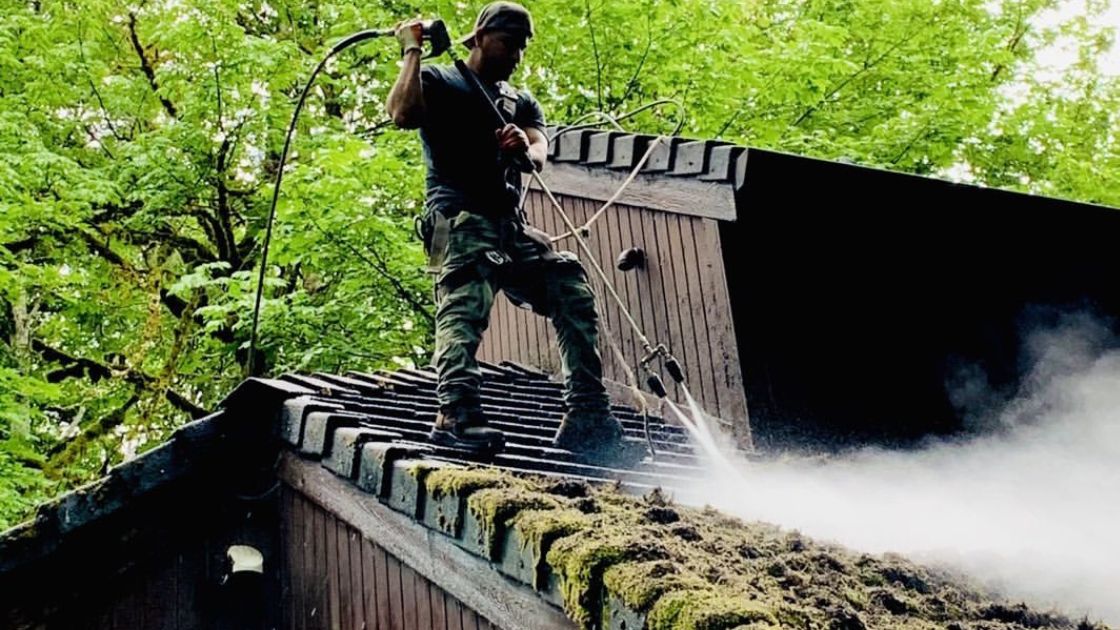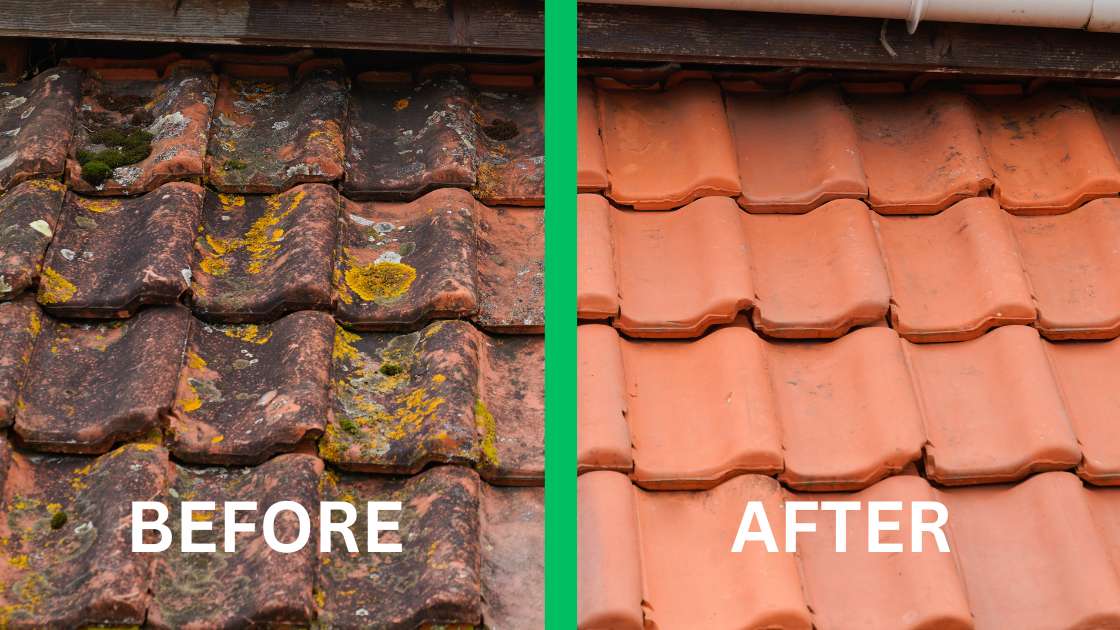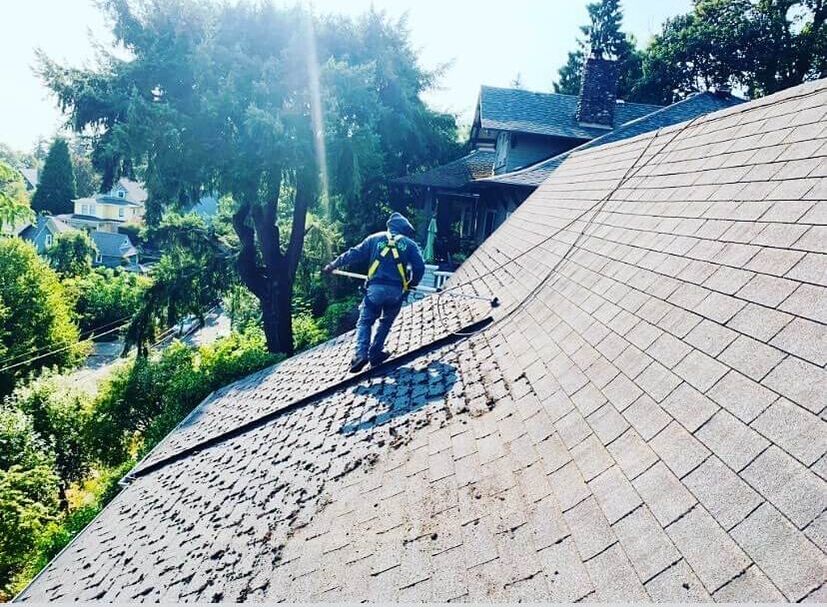|
A clean roof not only improves the appearance of your house as a whole but also contributes to the longevity of your roof. Regular cleaning may remove debris and prevent the growth of mildew and algae, which may compromise the structural integrity of your roof. This post will provide an overview of the best cleaning methods in connection with your kind of roof. Different Roof Types
Factors to Consider When Choosing Cleaning Methods for Various RoofsYour roof type is essential when choosing the best cleaning technique. But other elements must also be considered to ensure the cleaning procedure is efficient and secure for your roof. Roof's Age and ConditionThe proper cleaning technique should be determined by considering the age and condition of your roof. Older roofs may be more sensitive and need softer cleaning techniques, while newer roofs may be more resilient and survive more vigorous cleaning techniques. Presence of Moss or AlgaeFor example, asphalt shingle roofs are more vulnerable to moss and algae growth than other roofs. If left unchecked, moss and algae might ultimately damage your roof. So, tackling the moss and algae development on your roof is essential by using the appropriate cleaning method. Type of Roofing Material UsedFor diverse roofing materials, different cleaning methods are required. For instance, asphalt shingle roofs may benefit from pressure washing, whereas metal roofs need a milder clean to prevent surface damage. A gentler cleaning technique is necessary as pressure washing might result in tile roofs fracturing or cracking. Rubber roofs' substance requires a gentle cleaning technique that will not damage them. You must consider some aspects when choosing a cleaning method, including:
By taking these aspects into account, you can choose the roof cleaning procedure that is both effective and secure. 1. Pressure WashingPressure washing is a versatile and efficient cleaning technique that uses high-pressure water to remove stubborn dirt, grime, and other buildup from surfaces. It is especially useful for outdoor areas such as patios, driveways, and decks, where dirt and grime can accumulate over time due to exposure to the elements. It is an eco-friendly option and can restore surfaces to their like-new condition, making it a cost-effective way to improve the appearance and value of a property. The Advantages of Pressure Cleaning
Aspects to Take into Account Before Utilizing Pressure WashingWhile pressure washing is an effective cleaning method, it might damage your roof if done improperly. Keep the following in mind while using pressure washing to clean roofs:
Pressure washing is a rapid and efficient cleaning technique that eliminates stains, grime, and debris from your roof. Nonetheless, seeking expert assistance is recommended if you're unsure of your pressure-washing abilities. Recommended Pressure Washing Techniques for Different Roof TypesVarious roofs require different pressure washing methods to guarantee proper cleaning without harming the roof's surface.
You may adequately clean your roof without causing damage by utilizing the pressure washing methods advised for the various kinds of roofs, which will also increase the longevity of your roof. 2. Cleaning SolutionsThe cleaning alternatives for roof cleaning include bleach, eco-friendly cleaners, and cleaners of professional quality. Pros:
Cons:
When choosing a cleaning method appropriate for the kind and condition of your roof, it is crucial to weigh these advantages and disadvantages. To avoid harming the environment or causing damage to your roof while using cleaning solutions, always follow the manufacturer's instructions and safety standards. Guidelines for Safe and Efficient Cleaning Solution UseObserve the manufacturer's guidelines: The concentrations and use guidelines for various cleaning solutions vary. Reading and adhering to the manufacturer's instructions is crucial to use the cleaning solution safely and efficiently.
3. Hand ScrubbingA roof may be manually scrubbed using a brush or sponge using the manual scrubbing technique. This procedure is often performed when chemical cleaning or pressure washing is inappropriate due to the roof material or degree of grime and stains. Pros:
Cons:
Safety Tips for Manual Scrubbing The following advice may help you stay safe when physically cleaning your roof:
Take Breaks: The key to reducing weariness is to take rests and drink water. 4. Soft WashingThis method, which is more mild than pressure washing, is used to clean a variety of roof materials, such as tile, metal, and asphalt shingles. It might remove dirt and filth from your roof without harming the surface. When to Use Soft Washing and How It Works A low-pressure spray is used to administer a specifically made cleaning solution to the surface of the roof during soft washing. After a gentle rinse with a low-pressure water spray, the cleaning agent breaks down and loosens the dirt and grime. For delicate roofing materials like rubber and tile, which high-pressure washing might damage, it works well. Safety Tips for Soft WashingIt's crucial to abide by a few safety precautions while using mild cleaning solutions to avoid harm to yourself or harm to your roof:
ConclusionThe maintenance of your property must include cleaning the roof. Your roof's type, age, and condition will determine the optimum cleaning technique. Pressure cleaning works well for asphalt shingle roofs; hand scrubbing is advised for metal roofs. Rubber roofs need a particular cleaning method, whereas tile roofs might benefit from mild washing.
Frequent cleaning helps stop mold and algae development, which can harm your roof. You can keep your roof clean by trimming neighboring trees and removing trash. You should only try to clean your roof if you feel comfortable or can do so. Experienced roof cleaners have the tools and knowledge to clean your roof securely and efficiently. Keeping your roof clean is crucial to maintaining the condition of your house. You can ensure your roof stays in excellent condition for years by using the proper cleaning methods and getting expert assistance. While moss on a roof may be attractive, it may seriously harm your house's structure. On a roof, moss may gather moisture, destroying the shingles. Leaks, water damage, and expensive repairs might result from this. As moss gathers water on a roof, the shingles may deteriorate. Costly repairs, leaks, and water damage might ensue from this. To keep the house safe and in great shape, moss on the roof has to be removed. In order to stop moss from growing again, a roof has to be cleaned, prepared, and maintained. Follow this guide to clean moss off your roof. How to Remove Moss from Roof1. Materials and Tools NeededListed in detail below are the things you will need to efficiently remove moss from your roof: Moss Removal Solution: You have two options for removing moss: either you buy a commercial product or build your own at home using items like vinegar or bleach. The solution's role in breaking it down makes the moss simpler to remove. Garden Hose or Pressure Washer: After applying the moss removal solution to the roof, it is necessary to rinse it with a garden hose or pressure washer. This will assist in clearing the roof of any debris and loosening moss. Roof Cleaning Solution: When the moss has been eliminated, the roof must be cleaned and any leftover debris removed using a roof cleaning solution. A professional roof cleaning solution is available for purchase, or you may prepare your own at home using water, dish soap, and bleach. Safety Gear: Cleaning moss from a roof may be hazardous, so using the proper safety gear is essential. As protection from the moss and cleaning solution, this comprises gloves, safety goggles, and a mask. Ladder: To securely reach the roof, a ladder is required. Use a sturdy ladder, and have a helper keep it firm while you ascend and descend. Soft-bristled Brush or Scraper: To remove any last bits of moss or debris from the roof, use a soft-bristled brush or scraper. A metal scraper should not be used since it can harm the shingles. You can remove moss from your roof safely and efficiently while avoiding any harm to your property if you have all these supplies and equipment available. 2. PreparationBefore removing moss, preparing your roof and taking safety measures are essential. Here is a breakdown of the procedures involved:
While clearing moss from a roof, keep the following safety measures in mind:
You may ensure a secure and efficient moss removal procedure by adhering to certain pre-processing and safety precautions. 3. Removing MossThese are a few techniques for cleaning moss from a roof Moss Removal Solution This chemical solution is sprayed directly on the plant to destroy the moss. Usually, the solution is sprayed onto the roof and allowed to rest there for a certain period before being washed off. Choosing a solution that won't harm your roofing material is crucial as adhering carefully to the directions. If you need roof moss removal service. Since the procedure might differ based on the brand, carefully follow the directions on the moss removal solution. Usually, the solution has to be diluted with water before being sprayed over the moss. Before washing it with a garden hose or pressure washer, let the solution soak for the advised period. Pressure Washer To remove moss and other debris from the roof, use a pressure washer, which is a powerful instrument. The greatest roofs for this technique are those with much moss accumulation. It's crucial to use a low-pressure setting and keep a safe distance from the roof if not used properly. It may be harmful and harm the roofing material. Use a pressure washer with a low-pressure setting to prevent harming the roofing material. Spray the moss sweepingly while keeping a safe distance from the roof, beginning at the top and moving down. Soft-bristled Brush or Scraper With a soft-bristled brush or scraper, the moss is physically removed from the roof using this technique. It works well on rooftops when the moss accumulation is minimal. It may take some time and involve scaling a roof, so taking safety measures is crucial. The moss on the roof may be manually removed with a scraper or brush with soft bristles. Working your way down the roof, start at the top and do not harm the roofing material. Utilize a garden hose or pressure washer to remove any leftover material once the moss has been removed. You may successfully remove moss and restore the appearance of your roof by selecting the technique suitable for your roof and carefully following the instructions. 4. Cleaning the RoofIt's crucial to properly clean the roof after moss removal to avoid any lingering particles from damaging the shingles. The steps are as follows:
Cleaning the roof following moss removal is crucial to remove any lingering particles that might harm the shingles. Debris on the roof may retain moisture, damage the shingles, and cause leaks and expensive repairs if left there. 5. Maintenance and PreventionThere are a few maintenance guidelines to follow to stop moss from returning to your roof:
You may also apply a moss inhibitor treatment to your roof to stop moss from returning. This procedure will aid in halting the growth and spread of moss on the roof. ConclusionA roof must be cleaned of moss to remain secure and in outstanding condition.
The roof must be cleaned and maintained, and the moss must be removed to prepare the roof and stop it from growing again. Employ all necessary tools, materials, and customary safety precautions while cleaning moss from a roof. Maintaining a program for preventive and routine maintenance may also assist in avoiding the growth of moss. You may remove the moss without harming your roof or other property using the methods in this article. |
AuthorRip City Roof Cleaning specializes in providing expert roof and exterior cleaning services, ensuring homes and businesses look their best while maintaining structural integrity. Follow our tips for roof cleaning to maintain your roof's longevity and appearance. Categories
All
Archives
July 2024
|
SERVING ALL OF PORTLAND METRO & SURROUNDING AREAS |
BUSINESS HOURS
MON-FRI: 8AM TO 7PM SAT-SUN : 8AM TO 7PM |
CALL US TODAY
(971) 284-3558 SOCIAL MEDIALICENSED & INSURED
LLC # 655D595Q4 POLICY# NN1345586 |







